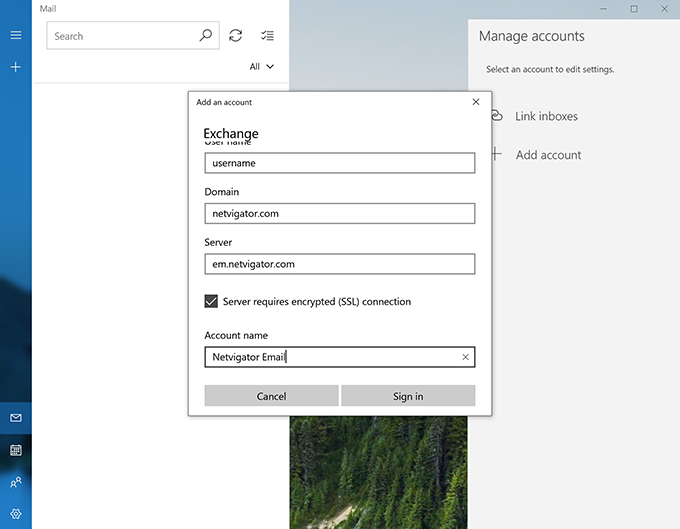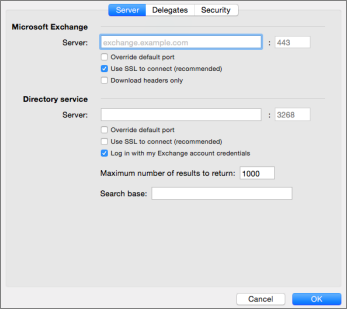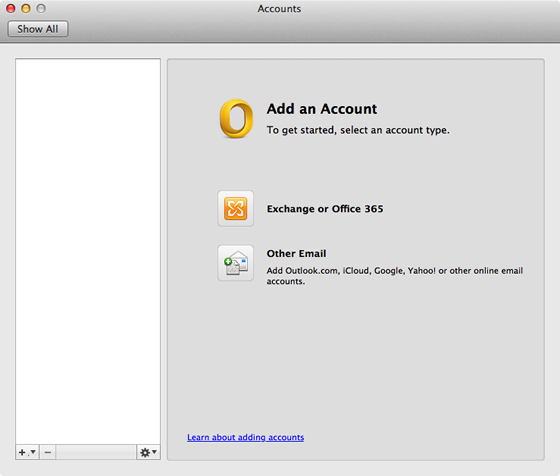It does indeed look like Outlook 2016 for Mac (included in Office 365 for Mac) supports Exchange 2010, but it needs to be Exchange 2010 SP3; this means previous Exchange 2010 versions might or might not work, but they are not supported. Documentation » Connect to the Exchange Server using a Mac. Connect to the Exchange Server using a Mac. Select the options you want to use with your Exchange server. Mac OS X Mail Setup - Setting up a Printer in Windows - Smartphone and Mobile Device Setup.
-->MacOS Server brings even more power to your business, home office, or school. Designed to work with macOS and iOS, macOS Server makes it easy to configure Mac and iOS devices. It’s also remarkably simple to install, set up, and manage. Add macOS Server to your Mac from the Mac.
Applies to: Exchange Server 2013
Looks like the latest version of Mac Mail on Sierra doesn't work with Exchange 2016. It works fine with our Exchange 2013 server. I am getting Unable to Verify account name or password. Outlook 2016 for Mac works fine and all windows clients are working fine so it seems to be a Mac Mail issue. Hi You may follow this below article for a work around to. Included in the Mac operating system. Supports smart folders and robust filters.
Learn about the Exchange 2013 requirements that you need to know before you install Exchange 2013. For example, you'll learn about the hardware, network, and operating system requirements.

Before you install Microsoft Exchange Server 2013, we recommend that you review this topic to ensure that your network, hardware, software, clients, and other elements meet the requirements for Exchange 2013. In addition, make sure you understand the coexistence scenarios that are supported for Exchange 2013 and earlier versions of Exchange.

Supported coexistence scenarios
The following table lists the scenarios in which coexistence between Exchange 2013 and earlier versions of Exchange is supported.
Coexistence of Exchange 2013 and earlier versions of Exchange Server
| Exchange version | Exchange organization coexistence |
|---|---|
Exchange Server 2003 and earlier versions | Not supported |
Exchange 2007 | Supported with the following minimum versions of Exchange:
|
Exchange 2010 | Supported with the following minimum versions of Exchange:
|
Mixed Exchange 2010 and Exchange 2007 organization | Supported with the following minimum versions of Exchange:
|
1 If you want to create an EdgeSync Subscription between an Exchange 2007 Hub Transport server and an Exchange 2013 SP1 Edge Transport server, you need to install Exchange 2007 SP3 Update Rollup 13 or later on the Exchange 2007 Hub Transport server.
2 If you want to create an EdgeSync Subscription between an Exchange 2010 Hub Transport server and an Exchange 2013 SP1 Edge Transport server, you need to install Exchange 2010 SP3 Update Rollup 5 or later on the Exchange 2010 Hub Transport server.
Supported hybrid deployment scenarios
Exchange 2013 supports hybrid deployments with Microsoft 365 or Office 365 organizations that have been upgraded to the latest version of Microsoft 365 or Office 365. For more information about specific hybrid deployments, see Hybrid deployment prerequisites.
Network and directory servers
The following table lists the requirements for the network and the directory servers in your Exchange 2013 organization.
Network and directory server requirements for Exchange 2013
| Component | Requirement |
|---|---|
Schema master | By default, the schema master runs on the first Active Directory domain controller installed in a forest. The schema master must be running one of the following:
|
Global catalog server | In each Active Directory site where you plan to install Exchange 2013, you must have at least one global catalog server running one of the following:
For more information about global catalog servers, see What is the Global Catalog. |
Domain controller | In each Active Directory site where you plan to install Exchange 2013, you must have at least one writeable domain controller running one of the following:
|
Active Directory forest | Active Directory must be at Windows Server 2003 forest functionality mode or higher.2 |
DNS namespace support | Exchange 2013 supports the following domain name system (DNS) namespaces:
For more information about DNS namespaces supported by Exchange, see Microsoft Knowledge Base article 2269838, Microsoft Exchange compatibility with Single Label Domains, Disjoined Namespaces, and Discontiguous Namespaces. |
IPv6 support | In Exchange 2013, IPv6 is supported only when IPv4 is also installed and enabled. If Exchange 2013 is deployed in this configuration, and the network supports IPv4 and IPv6, all Exchange servers can send data to and receive data from devices, servers, and clients that use IPv6 addresses. For more information, see IPv6 support in Exchange 2013. |
1 Windows Server 2012 R2 and Windows Server 2016 are supported only with Exchange 2013 SP1 or later.
2 Windows Server 2012 R2 or Windows Server 2016 forest functionality mode is supported only with Exchange 2013 SP1 or later.
Directory server architecture
The use of 64-bit Active Directory domain controllers increases directory service performance for Exchange 2013.

Note
In multi-domain environments, on Windows Server 2008 domain controllers that have the Active Directory language locale set to Japanese, your servers might not receive some attributes that are stored on an object during inbound replication. For more information, see Microsoft Knowledge Base article 949189, A Windows Server 2008 domain controller that is configured with the Japanese language locale may not apply updates to attributes on an object during inbound replication.
Installing Exchange 2013 on directory servers
For security and performance reasons, we recommend that you install Exchange 2013 only on member servers and not on Active Directory directory servers. However, you can't run DCPromo on a computer running Exchange 2013. After Exchange 2013 is installed, changing its role from a member server to a directory server, or vice versa, isn't supported.
Hardware
The recommended hardware requirements for Exchange 2013 servers vary depending on a number of factors including the server roles that are installed and the anticipated load that will be placed on the servers.
For detailed information on how to properly size and configure your deployment, see Exchange 2013 Sizing and Configuration Recommendations.
For information about deploying Exchange in a virtualized environment, see Exchange 2013 virtualization.
Hardware requirements for Exchange 2013
| Component | Requirement | Notes |
|---|---|---|
Processor |
| See the 'Operating system' section later in this topic for supported operating systems. |
Memory | Varies depending on Exchange roles that are installed:
| None. |
Paging file size | The page file size minimum and maximum must be set to physical RAM plus 10 MB, to a maximum size of 32778MB if you're using more than 32GB of RAM. | For detailed pagefile recommendations, see the 'Pagefile' section in Exchange 2013 Sizing and Configuration Recommendations. |
Disk space |
| For detailed information on storage recommendations, see Exchange 2013 storage configuration options. |
Drive | DVD-ROM drive, local or network accessible | None. |
Screen resolution | 1024 x 768 pixels or higher | None. |
File format | Disk partitions formatted as NTFS file systems, which applies to the following partitions:
Disk partitions containing the following types of files can be formatted as ReFS:
| None. |
Operating system
The following table lists the supported operating systems for Exchange 2013.

Important
We don't support the installation of Exchange 2013 on a computer that's running in Windows Server Core mode. The computer must be running the full installation of Windows Server. If you want to install Exchange 2013 on a computer that's running in Windows Server Core mode, you must convert the server to a full installation of Windows Server by doing one of the following steps:
Windows Server 2008 R2: Reinstall Windows Server and select the Full Installation option.
Windows Server 2012 R2 or Windows Server 2012: Convert your Windows Server Core mode server to a full installation by running the following command.
Supported operating systems for Exchange 2013
| Component | Requirement |
|---|---|
Mailbox, Client Access, and Edge Transport server roles | One of the following:
|
Management tools | One of the following:
|
1 Windows Server 2012 R2 is supported only with Exchange 2013 SP1 or later.

2 Windows 8.1 is supported only with Exchange 2013 SP1 or later.
Supported Windows Management Framework versions for Exchange 2013
Exchange 2013 only supports the version of Windows Management Framework that's built into the release of Windows that you're installing Exchange on. Don't install versions of Windows Management Framework that are made available as stand-alone downloads on servers running Exchange.
Microsoft Exchange Server Mac Os X
.NET Framework
We strongly recommend that you use the latest version of .NET Framework that's supported by the release of Exchange you're installing.
| Exchange 2013 version | .NET Framework 4.8 | .NET Framework 4.7.2 | .NET Framework 4.7.1 | .NET Framework 4.6.2 |
|---|---|---|---|---|
| CU23 | X | X | ||
| CU21, CU22 | X | X | ||
| CU19, CU20 | X | X | ||
| CU16, CU17, CU18 | X | |||
| CU15 | X |
Note: For older versions of the .NET Framework, see the Exchange Server supportability matrix
Supported clients
Exchange 2013 supports the following versions of Outlook and Entourage for Mac:
- Microsoft 365 Apps for enterprise
- Outlook 2019
- Outlook 2016
- Outlook 2013
- Outlook 2010
- Outlook 2007
- Entourage 2008 for Mac, Web Services Edition
- Outlook for Mac for Office 365
- Outlook for Mac 2011
For a list of Outlook releases that Exchange supports, see Outlook Updates.
Important
Exchange Server For Mac Os Versions
We strongly recommend that you install the latest available service packs and updates available so that your users receive the best possible experience when connecting to Exchange.
Outlook clients earlier than Outlook 2007 are not supported. Email clients on Mac operating systems that require DAV, such as Entourage 2008 for Mac RTM and Entourage 2004, are not supported.
Outlook Web App supports several browsers on a variety of operating systems and devices. For detailed information, see What's new for Outlook Web App in Exchange 2013.
Exchange Server For Mac Os High Sierra
Mail User Guide
Use Server Settings preferences in Mail to change options for an account’s incoming and outgoing (SMTP) mail servers.
To change these preferences in the Mail app on your Mac, choose Mail > Preferences, click Accounts, then click Server Settings.
Note: The settings you see vary depending on your account type.
Incoming mail server settings
Option | Description |
|---|---|
User Name | Your user name on the mail server. |
Password | Your password on the mail server. |
Host Name | The name of the mail server. |
Automatically manage connection settings | Mail automatically manages settings for your email account in Mail, such as port numbers and authentication methods. If you deselect this option, you can specify the following, as directed by your email account provider:
|
Advanced IMAP or Exchange Settings | Enter or change these settings as directed by your email account provider:
|
Outgoing mail server (SMTP) settings
Option | Description |
|---|---|
Account | The account of the mail server. To change outgoing server settings, as directed by your email account provider, click the Account pop-up menu, then choose Edit SMTP Server List. |
User Name | Your user name on the mail server. |
Password | Your password on the mail server. |
Host Name | The name of the mail server. |
Automatically manage connection settings | Mail automatically manages settings for your email account in Mail, such as port numbers and authentication methods. If you deselect this option, you can specify the following, as directed by your email account provider:
|
